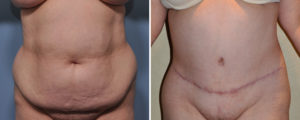A panniculectomy is a very close cousin to a tummy tuck or abdominoplasty. The term pannus refers to a large apron of skin and fat that hangs over the waistline.
The abdominal panniculectomy, surgical removal of a pannus, is a somewhat historic term now as it really refers to the pre-bariatric surgery era when obese individuals had a large pannus that hung down. At that time, many abdominal panniculectomy procedures were done to relieve the medical symptoms that the pannus caused. Specifically, skin irritations and rashes (known as panniculitis) resulted from the always present moisture and heat in the underlying skin fold. In some cases, the size of the pannus and its amount of overhang actually cut off some of the blood supply and lymphatic outflow resulting in swelling and infection. Surgically removing the pannus was common then but the complication rate was high due to the patient’s obesity. Today, surgical removal of any abdominal overhang would await weight loss through bariatic surgery.

In the historic obese patient, there was a significant improvement in the patient’s quality of life as the skin and infectious symptoms that it caused were eliminated as well as the weight removal improved back and knee pain. Because of the relief of medical symptoms, the abdominal panniculectomy was often covered by insurance. Since the panniculectomy procedure in the bariatric surgery patient today weighs considerably less and often only involves improvement of an undesired contour, it is often called cosmetic by one’s health insurance. To be considered medically eligible for insurance coverage, there has to be very specific criteria that are met and a documented trail of medical records that substantiate symptoms related to the pannus. Often times even with solid medical evidence, it will be denied coverage.
Most simple abdominal panniculectomy procedures are largely done in men. Men don’t need muscle tightening and a simple skin overhang removal is often enough. Women usually require a true tummy tuck to get the abdominal contour that they desire.
Dr. Barry Eppley
Indianapolis, Indiana


